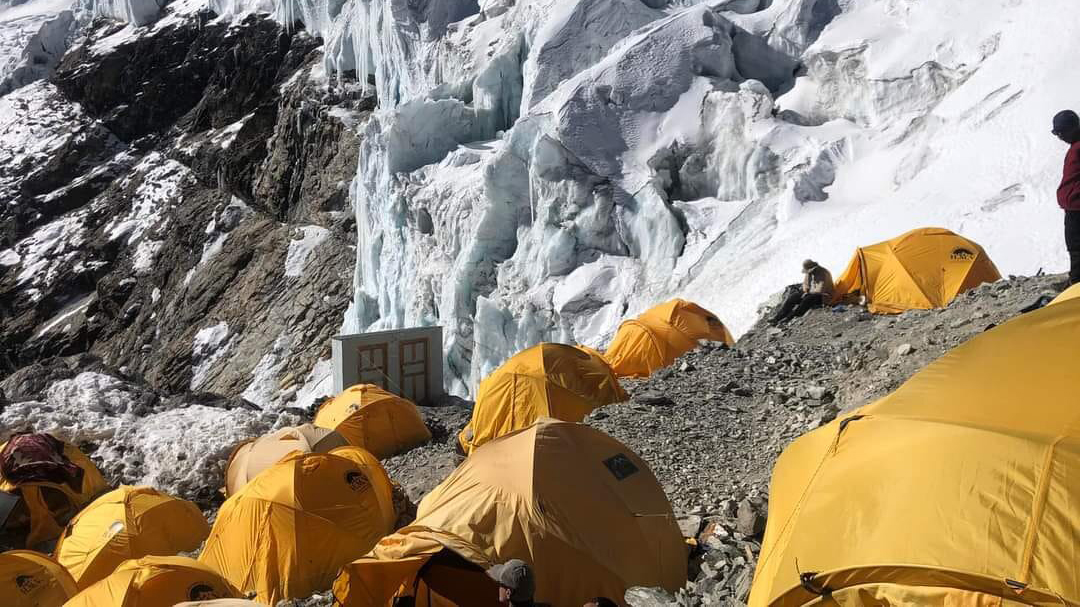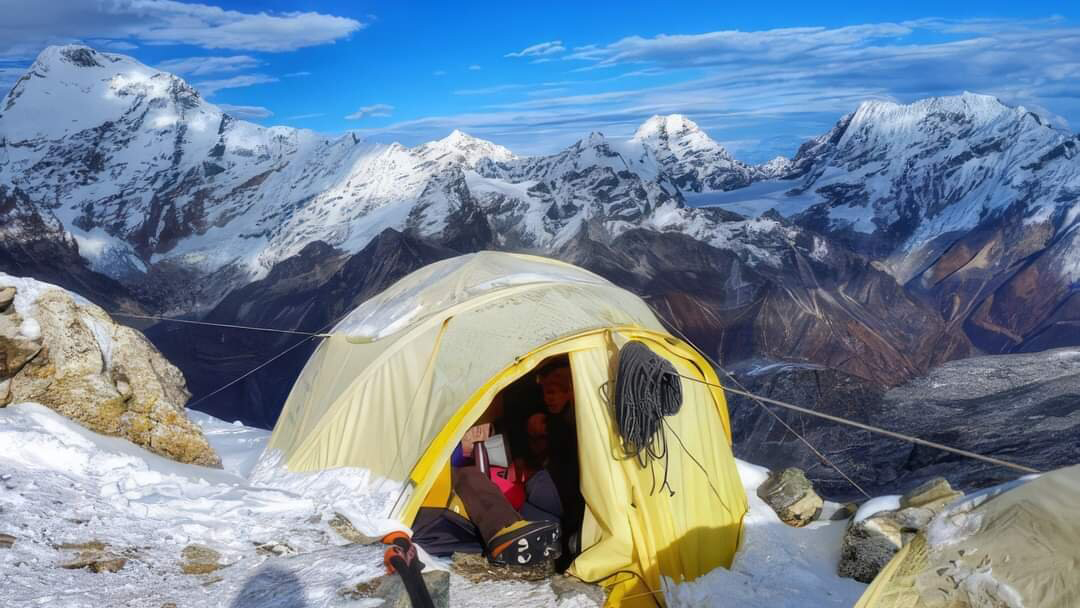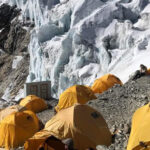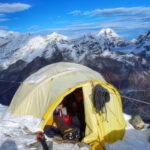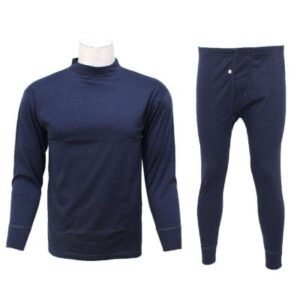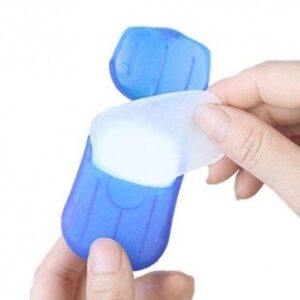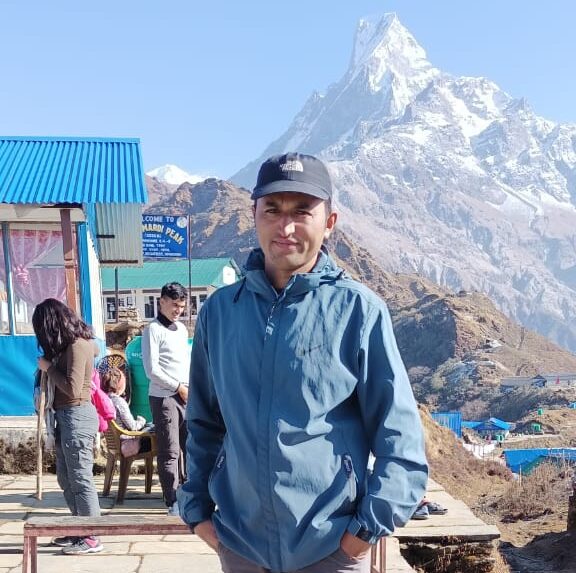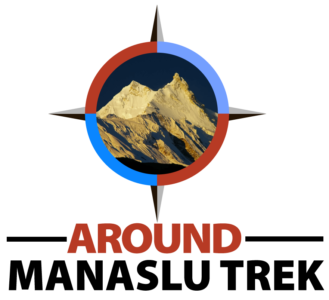Mera Peak Climbing
Trip Facts
- Destination Nepal
- Activity Climbing
- Duration 17 Days
- Trip Difficulty challenging
- Max. Altitude 6450
- Best Time Sep to Dec & March to May
- Start and End Kathmandu - kathmandu
- Meals Breakfast, Lunch, and Dinner
- Accommodation 3 star hotel in Kathmandu &Camping/ Tea house
- Group Size 2 - 10
- Transportation Private transport & Flight Ticket
Trip Highlights
- An exciting adventure standing on top of Nepal’s highest trekking peaks
- Explore the hidden and scenic Hinku Valley around undisturbed areas of Khumbu
- Adventure on off the beaten tracks in complete tranquility of mountain wilderness
- Far from main villages following the serene trails to high Mera Peak base camp
- Enjoy spectacular panorama of world’s highest peaks from the top of Mera Peak
- Camp under starry skies at high-altitude base camps, surrounded by towering peaks.
- Experience the thrill of ascending from lush valleys to snow-capped summits.
- Engage with local Sherpa guides and porters, learning about their culture and mountaineering traditions.
- Enjoy a spectacular panorama of the world’s highest peaks from the summit of Mera Peak.
Introduction
RP Adventures presents an exclusive and exciting adventure, “Mera Peak Climbing.” The walk takes you around the hidden pockets of the Khumbu and Everest regions towards the scenic Hinku Valley. Mera Peak, at 6,476 m or 21,247 feet, stands as the highest trekking peak in the Nepal Himalayas and is on the list of the NMA (Nepal Mountaineering Association), the governing body that controls most of the the trekking peaks in Nepal.
The grade of the climbs is PD, which means Peu Difficult, due to its high elevation and few crevasses. As well as the walk and climb on mountains, rocky paths, glaciers, ice, and snowy ridges. The grade is applied to the famous French and Swiss Alpine Climbing Classification Systems. In earlier days, the grade was just ‘F’ meaning ‘Facial Easy’, but during the past few years, due to avalanches that have created large crevasses and changes to the normal route to the summit of Mera Peak,.
However, Mera Peak Climbing is becoming much more popular among enthusiastic trekkers and adventurers. The Mera climb involves fewer technical challenges than other trekking peaks in Nepal, making it an interesting venture. Mera Peak Climbing is quite different from various popular trekking routes. The walk takes you into complete isolation, away from the main human settlements and villages, into sheer wilderness.
The trek begins in Lukla Town, after flying in from Kathmandu and then heading away from the main trail. The trail follows through a lovely, serene forest of rhododendron, pine, and fir trees, and then up to cross Naulekh. Also called Kalo Himal of solid rocks, then over the Zatwar-La pass to reach the beautiful Hinku Valley. The walk leads to the farthest end of Hinku Valley, past a few temporary settlements with simple lodges.
Then reaching Khare, the base camp for Mera Peak, which has the last lodge and temporary settlement. Having a rest day for acclimatization and practice climbs, head for the big climb to the summit of Mera Peak. Upon leaving the High Camp, the climb leads to a steep uphill ridge covered in deep snow. After hours of strenuous climbing, I reached the top of Mera Peak, feeling in high spirits and on top of the world.
Enjoy the jaw-dropping panorama of giant peaks that encircle the Mera Peak summit, facing views of Mt. Everest, including views of Lhotse, Nuptse, and Ama Dablam with Baruntse Himal, Mt. Makalu, and as far as Mt. Kanchenjunga. After a wonderful scenic moment, descend safely back to Khare and then begin the return journey to Lukla. Following the same scenic route makes a difference, as you feel much better after losing altitude. Finally, the last climb takes you over Zatwar-La Pass to enter the forest at Chutanga, then reach Lukla.
For the last overnight halt around the high Khumbu region of Everest. The next morning, a short flight brings you to Kathmandu. Where our marvelous adventure concludes, after a glorious experience on the Mera Peak Trek and Climb.
Join us for an exhilarating climbing experience to the summit of Mera Peak, standing tall at an impressive elevation of 6461m. This adventure is not just about reaching the top but also about embracing the challenges of trekking, hiking, and the technical aspects of mountain climbing. This expedition demands physical strength, mental resilience, and a deep passion for adventure.
Our carefully designed 20-day itinerary allows you to engage fully with the trek and acclimate appropriately. The expedition begins and ends in the city of Kathmandu, giving you a taste of Nepal’s rich culture and historical heritage as well. The journey to the peak traverses through pristine landscapes and traditional villages and offers mesmerizing views of the mighty Himalayas. We move from teahouses to camping sites, ensuring a diverse and authentic experience. It’s a challenging climb, but one that is incredibly rewarding.
Included in our full-board package at $4000, we provide all necessary climbing permits and Makalu National Park permits. The group size will range from 2 to 20 people, and for larger groups, we are able to customize costs. Nepal is home to numerous climbing peaks ranging from 5500 m to 6461 m, and Mera Peak promises to be an adventure that stands out.
Best Seasons for Mera Peak Climbing
The best seasons for Mera Peak Climb are spring and autumn. The spring season begins from March to May when most days are full of sunshine. The right time for wildflowers is when they are in seasonal bloom, especially the rhododendrons of various species and colors. Afternoons can get overcast with a few showers and sometimes snowfall, with cold mornings and nights, altitude-wise.
The next best season is autumn/fall, starting from September to November. Most days are fine and crystal clear for views and pleasant walks, but mornings, late afternoons, and nights can be cold. One can expect snowfall above 3,000 m sometimes.
What to Expect on Mera Peak Trek & Climb?
- Mera Peak is one of the highest trekking peaks in the Nepal Himalayas, located within the Khumbu area inhabited by the Sherpas, the Highlanders of Everest and Eastern Himalayas. The Sherpa follows Tibetan Buddhism, known as the Mahayana of the Nyingma sect, with every house adorned with prayer flags.
- The villages are lined with Buddhist monuments of stupas and prayer walls. Enjoy walks within serene woods of tall rhododendron, pines, and fir trees.
- Grand views of giant snow peaks are available on daily walks from Lukla to Mera Peak base camp. Closest views of Mt. Everest from the summit of Mera Peak with Makalu as far as Kanchenjunga on the east horizon
- Enjoy the walks in the comfort of a nice cozy lodge and guest house with the warm traditional hospitality of the native Sherpa. Includes overnights in a tented camp at Mera Peak Base Camp for one overnight, until the climb is completed.
- All meals are prepared by our camping cook and kitchen staff. Enjoy the beautiful wild landscapes. Amidst the towering, gigantic mountain range that surrounds the Mera Peak Summit
- Safe and successful climb and descent, as weather permits, on the day of ascent to Mera Peak Summit. A short and scenic flight both ways from Kathmandu-Lukla-Kathmandu facing a breathtaking panorama of the Himalayan Mountain range with a view of Mt. Everest
Outline Itinerary
Day 01: Arrival in Kathmandu and transfer to hotel – 1,300m.
Day 02 : In Kathmandu with optional sightseeing tour and trek preparations – 1,300m.
Day 03: Fly to Lukla 2,820 m & trek to Chutanga 3, 020m – 04 hrs.
Day 04: Trek to Thuli Kharka 3,900 m via Zatrawa – La Pass 4,610m – 06 hrs.
Day 05: Trek to Kothey 4,200m – 05 hrs.
Day 06: Trek to Thagnak 4,350m- 05 hrs
Day 07: Rest day at Thagnak for acclimatization and hike – 4,350m.
Day 08: Trek to Khare / Mera Peak Base Camp 5,045m – 04 hrs.
Day 09: Rest day for acclimatization and preparation – 5,045m.
Day 10: Trek to Mera Peak High Camp 5,700 – 04 hrs.
Day 11: Climb to Mera Peak Summit 6,470m return to Khare – 08 / 09 hrs.
Day 12: Trek to Kothey 4,095m – 06 hrs
Day 13: Trek to Thuli-Kharka 3,900m – 06 hrs
Day 14: Trek to Chutanga via Zatwar-La pass 4,610m – 05 hrs
Day 15: Trek to Lukla for last overnight stop 2,810m – 04 hrs
Day 16: Fly from Lukla to Kathmandu with afternoon free at leisure – 1,300m
Day 17: International departure for homeward bound -1,300m
Alternative Treks & Climbs Around Mera Peak Climbing
Mera Peak is a thrilling climb, but if you’re looking for something different in the same region, there are plenty of other treks and climbs to consider. Whether you want a tougher challenge, a quieter trail, or just a fresh perspective of the Himalayas, here are some great options:
- Island Peak & Everest Base Camp Trek – 19 Days: Combine the excitement of summiting Island Peak with the iconic trek to Everest Base Camp, offering a perfect mix of trekking and climbing in the heart of the Himalayas.
- Everest Three High Passes Trek – 20 Days: For a true high-altitude challenge, this trek takes you over three tough passes, giving you incredible views of Everest and surrounding peaks.
- Everest Base Camp Via Gokyo & Cho-La Pass Trek – 17 Days: Experience Everest from a different angle by trekking through the stunning Gokyo Lakes and crossing the challenging Cho-La Pass on your way to Base Camp.
Detailed Itinerary
-
Day 01: Arrival in Kathmandu and transfer to hotel - 1,300m
On arrival at Kathmandu, Nepal International Airport, check the Nepal Standard Time, which is 5 hours and 45 minutes ahead of GMT. Outside the airport terminal, our staff from RP Adventures will greet you and escort you for a short drive to your hotel. The hotel is located in the hub of Kathmandu. Upon arrival, check into your lovely rooms. Then, meet with the other members of the trek and climb for a briefing regarding the Mera Peak Trek and Climb. After collecting all the useful information and trek details, enjoy an evening group welcome dinner at a nice authentic Nepali restaurant, which will introduce you to Nepali foods and cultures.
Altitude: 1300mMeals: Breakfast / lunch / DinnerAccommodation: 3 star hotel in Kathmandu -
Day 02 : In Kathmandu with optional sightseeing tour and trek preparations - 1,300m
Enjoy a free day in Kathmandu to prepare for the trek and explore Nepal's famous landmarks. Kathmandu Valley and its adjoining cities boast historical monuments listed as World Heritage Sites. Visit Old Durbar Square, an ancient palace and royal courtyard, and explore the oldest Buddhist stupa of Swayambhunath. Additionally, see the famous Hindu temple of Pashupatinath and the large dome stupa of Boudhanath before returning to the hotel. After an exciting tour, spend the afternoon preparing for the Mera Peak Trek and Climb.
Altitude: 1300mMeals: Breakfast / lunch / DinnerAccommodation: 3 star hotel in Kathmandu -
Day 03: Fly to Lukla 2,820m & trek to Chutanga 3,020m - 04 hrs
Early in the morning, board a small aircraft for a short flight to Lukla, departing from the hotel. The plane offers stunning views of the Himalayan peaks and a panoramic view of the Kathmandu Valley as it ascends. After a brief flight, you land on the unique runway of Lukla Tenzing & Hillary Airport.
Upon arrival in Lukla, take a refreshing break before starting the pleasant walk that leads away from the last human settlements, villages, and towns. The trail heads north through dense forests of pines and rhododendrons. Pass several smaller cattle herd shelters before reaching Chutanga for the overnight halt. Stay in a nice, simple lodge with views facing the Dudh Koshi River Valley and Kongde Peak to the southwest.
Altitude: 3320mMeals: Breakfast / lunch / DinnerAccommodation: Tea house -
Day 04: Trek to Thuli Kharka 3,900m via Zatrawa-La Pass 4,610m - 06 hrs
The morning begins with a climb up steep, rocky ridges that takes over an hour. Upon reaching the top of Naulekh / Kalo Himal, spectacular views of Lukla town and its runways unfold, along with grand scenery of the Dudh Koshi valley, Kwangde peaks, and Numbur Himal. The trail then crosses over Zatwar-La pass at over 4,610 m, followed by a long descent to Thuli-Kharka. Arrive in the forested area for an overnight stop in an isolated small settlement, where there are a few simple lodge accommodations.
Altitude: 3900mMeals: Breakfast / lunch / DinnerAccommodation: Tea house -
Day 05: Trek to Kothey 4,200m - 05 hrs
From Thuli-Kharka, the trail winds deeper into the Hinku Valley, an area less frequented by trekkers. It passes through winding paths within a beautiful forest of rhododendrons, oaks, pines, and fir trees. After a rewarding hike of over 4 hours, we reach Kothey for our overnight stay. It's a serene spot with a small temporary settlement of cattle herders and a few simple lodges.
Altitude: 4200mMeals: Breakfast / lunch / dinnerAccommodation: Tea house -
Day 06: Trek to Thagnak 4,350m - 05 hrs
Altitude: 4450mMeals: Breakfast / lunch / dinnerAccommodation: Tea house -
Day 07: Rest day at Thagnak for acclimatization and hike - 4.450m
Enjoy a rest day at Thagnak to acclimatize before continuing higher towards Mera Peak base camp. This altitude is perfect for acclimatization. Spend the day exploring the valley and its viewpoints, where you can enjoy grand views of Peak 43, standing at 6,769 meters. You'll also catch glimpses of Mera Peak in the eastward direction, preparing you for the ascent ahead.
Altitude: 4450mMeals: BreakfastAccommodation: Tea house -
Day 08: Trek to Khare / Mera Peak Base Camp 5,045m - 04 hrs
From Thagnak, the adventure continues towards our main destination, Mera Peak Base Camp, in a place called Khare. The morning trek spans about four hours, leading towards the end of Hinku Valley. The trail ascends over moraine terrain, nearing a dam called Charpatti Tal, which is a square-shaped glacial pond. From here, the route climbs over cairns of rocky moraine and descends to Dig Kharka. You'll traverse a landscape strewn with large boulders and high ridges before reaching Khare for the overnight stop. Khare is a small settlement with a few simple lodges, serving as the base camp for Mera Peak. The area is surrounded by high cliffs and snow-capped peaks, nestled at the foot of Mera Peak.
Altitude: 5045mMeals: Breakfast / lunch / DinnerAccommodation: Camping -
Day 09: Rest day for acclimatization and preparation - 5,200m
Enjoy another necessary rest and spare day at Khare, Mera Peak base camp, where you'll have time for climbing practice. The guides will provide instructions and relevant information for the Mera Peak climb. The rest of the day will be spent preparing and checking the climbing gear for the big ascent.
Altitude: 5200mMeals: Breakfast / lunch / DinnerAccommodation: Camping -
Day 10: Trek to Mera Peak High Camp 5,700m - 04 hrs
After a pleasant rest and relaxing time at Khare, you'll be ready for the day as you move closer to our final highlight destination. The day begins with a climb towards Mera La Pass, which serves as the boundary between Hinku and Hongu Valleys. After several hours of a tough ascent, you'll reach High Camp, where tents are set up on the best available flat ground. After enjoying lunch, you'll rest to conserve energy for the early morning climb. Our guides will check the route and ensure preparations are in order. Although it is a non-technical climb to the summit of Mera Peak, climbers need to be well-equipped.
Altitude: 5700mMeals: Breakfast / lunch / DinnerAccommodation: Tea house -
Day 11: Climb to Mera Peak Summit 6,470m return to Khare 08 - 09 hrs
The main highlight of the adventure begins with an early departure from camp, before dawn, to avoid the cold wind chill and slippery trails before the sun reaches the summit. Following the lead guide, you'll ascend over snowy slopes, carefully navigating around deep crevices. The climb becomes steeper as altitude is gained, until finally reaching the summit of Mera Peak. After a well-deserved rest to relax your mind and body, you can enjoy the rewards of your hard climb. Standing atop one of Nepal's highest trekking peaks, you'll be greeted by breathtaking views of the Mid-East Himalayas, including Mt. Everest, Mt. Lhotse, Mt. Makalu, and Mt. Cho-Oyu, as well as Makalu and Mt. Kanchenjunga in the distance. After experiencing these exhilarating moments, descend safely back to the base camp at Khare.
Altitude: 5500mMeals: Breakfast / lunch / DinnerAccommodation: Tea house -
Day 12: Trek to Kothey 4,095m - 06 hrs
Departing from Khare, the base camp, ensure to leave the area clean by clearing all garbage, leaving nothing behind except your footprints. Follow the same route back to Thagnak, passing by Charpatti Tal / Lake, and then continue through the vegetation and tree lines. The trail heads further west to reach Kothey, where you can enjoy a pleasant overnight stop amidst the lovely woods.
Altitude: 4095mMeals: Breakfast / lunch / DinnerAccommodation: Tea house -
Day 13: Trek to Thuli-Kharka 2,810m - 06 hrs
From Kothey, you'll retrace your steps along the same serene forested trail, passing by cattle herder summer camps. At the end of the day, you'll reach Thuli Kharka for your final overnight stay in the hidden Hinku Valley.
Altitude: 2810mMeals: Breakfast / lunch / DinnerAccommodation: Tea house -
Day 14: Trek to Chutanga via Zatwar , La pass 4,610m - 05 hrs
The morning begins with a hearty breakfast, followed by a steep climb to cross over Zatwar-La Pass. You'll be greeted by breathtaking scenery of the surrounding high, snow-capped peaks and the lush green Dudh Koshi River valley below. After descending steeply, you'll return to the dense tree lines at Chutanga for your final overnight stay in the mountain wilderness before heading back to Lukla.
Altitude: 3200mMeals: Breakfast / lunch / DinnerAccommodation: Tea house -
Day 15: Trek to Lukla for last overnight stop 2,810m - 04 hrs
As the adventure slowly comes to an end, you'll enjoy the final day's walk to Lukla, passing through dense forests and farm areas. The trail leads you to Lukla, situated near its airport, where you'll find good lodges. Check into a nice lodge for lunch and an overnight stay, with time to celebrate with the trekking crew and porters.
Altitude: 2810mMeals: BreakfastAccommodation: Tea house -
Day 16: Fly from Lukla to Kathmandu with afternoon free at leisure - 1,300m
An early start to catch the flight back to Kathmandu, after breakfast, a short walk to Lukla’s Tenzing & Hillary Airport. As the plane arrives from Kathmandu, board a smaller aircraft for a sweeping flight to Kathmandu. On reaching Kathmandu Airport domestic terminal, and then transferring back to your hotels, have a free afternoon for individual activities.
Altitude: 1300mMeals: BreakfastAccommodation: 3 star hotel in Kathmandu -
Day 17: International departure for homeward bound - 1,300m
The final day in Kathmandu and Nepal is aligned with your international flight schedule. RP Adventures guides and staff will transfer you to the airport, where you bid farewell to them. Proceed to the airport terminal for your homeward-bound flight, reflecting on your great experience and adventure on the Mera Peak Trek and Climb.
Altitude: 1300mMeals: Breakfast
What's included
- Experienced English-speaking guide and porter
- Climbing guide
- International and domestic pickup and drop-off by private vehicle"
- Trekking permits, Climbing permits,Makalu National park permits
- 3-star hotel in Kathmandu for 3 nights (bed and breakfast)
- Food and accommodation, including tea/coffee, during the trek
- Camping tent and kitchen staff during camping
- Private vehicle for Kathmandu Sightseeing
- Flight tickets from Kathmandu to Lukla and back
- Satellite phone
- Medical kit
- Guide and porter insurance food and Accommodation
- Sleeping bag ,duffle bag ,Down jacket and trekking poles
- Climbing Equipment During climbing time
What's not included
- International flight ticket
- Nepal visa fee
- Personal medical /travel insurance
- Guide and porter tips
- Personal equipment
- Personal bill
- Kathmandu lunch/dinner
Trekking Gears
To ensure a safe and comfortable trek in the Himalayan region, it is highly recommended to bring the appropriate equipment and gear to cope with the cold temperatures. The following is a list of essential equipment and gear, which can be purchased either in the Thamel market or brought from your home country:
Baggage
- 70-100 liters Duffel bag
For trekking and expeditions, a duffel bag is essential to pack all kinds of trekking equipment. Duffel bags come in various sizes, ranging from 60 liters to 100 liters. There are different brands available, such as The North Face, Sonam, Sherpa, Rab, and Everest Hikes. You can purchase these bags both online and offline in your homeland or in Kathmandu, particularly in Thamel's trekking shops. The cost varies depending on the brand, ranging from $15 to $100.
- Water proof day pack 30-40 liters
For hiking and trekking, you can choose from various brands of day bags. We recommend a 30 to 45-liter waterproof, strong, and good-quality day bag. Prices range from $40 to $200, depending on the brand and quality. You can purchase it in your homeland or buy it at the Thamel market (a trekking shop). Typically, this bag is used for day hiking and carries toiletries, emergency medical supplies, snacks, a water bottle, a jacket, warm shirts/t-shirts, a hat, trekking poles, and gloves.
Rain, wind, and snow are common in trekking areas. Typically, to avoid rain, we use a poncho, which also helps keep our body, clothes, and day pack dry. The cost of a raincoat is $10 to $50, depending on the quality, and it can be found in Thamel (a trekking shop). Alternatively, if possible, you can bring one from your own source.
- Power Bank / Trekking Solar
In the Himalayas, a trekking area, electricity is limited due to a small hydro power station. Sometimes, the electricity may not work, and often solar panels are used in most places. If the day is not sunny, then solar panels may not work. In that case, we can use our own backup to charge electronic devices. The quality makes the price vary from $50 up to $150. You can buy it in a Kathmandu trekking shop, or you can bring it on your own.
During mountain treks, it is essential to stay hydrated by drinking either hot or cold water. The mountain water is robust and rich in minerals. Having a water filter machine allows you to filter this water. This is not only environmentally friendly but also cost-effective, as plastic bottled water can be expensive. The price range for water filters is $50 to $100, depending on the brand. You can purchase one in your own country or buy it at a Thamel trekking shop.
- Sleeping bag (comfort rated _20)
Normally, we use a sleeping bag during camping trekking and teahouse trekking. In teahouses, we are provided with blankets, but during the busy season, the blankets may not be sufficient. That's why we highly recommend owning a sleeping bag. Sleeping bags come in different types, ranging from -5 degrees to -30 degrees, and they vary in price. If you choose to buy a local Nepali product, the cost may not be expensive, ranging from Rs 5000 to Rs 20000. However, if you prefer a brand like The North Face, Sonam, Sherpa, or RAV, the cost can range from $200 to $1000. You can purchase them online or offline.
In Nepal, you have the option to rent or buy a sleeping bag. If you opt for a trekking package, the organizer will arrange sleeping bags based on different trekking areas.
During our Himalaya trekking, we ventured into remote areas where electricity and lighting systems were scarce, even in teahouses and high passes such as Thorang Pass, Larkey Pass, and the three high passes. In these places, especially during nighttime trips to the toilet or while crossing high passes, a headlight is essential. Headlights come in different types, including a normal one, one with a battery, or another with an electric source, ranging in cost from $10 to $50. You can purchase them online or offline, either from trekking shops in Thamel or in your home country.
- Water bottles 1 lit 2

During Himalayan trekking, it is advisable to carry two types of bottles: a 1-liter small thermos for hot water, tea, or coffee, and another 1-liter bottle for regular drinking water. The prices for these bottles range from $7 to $50. You can purchase them at Thamel trekking shops or in your home country. In Nepal, these bottles are available both online and offline.
During Himalayan hiking and trekking, it is essential to have sunglasses that provide protection against dust, wind, snow, cold, and heat. Different weather conditions require different types of sunglasses. We highly recommend reputable brands for sunglasses, with prices ranging from $10 to 200%. These sunglasses are readily available both online and offline. You can conveniently purchase them from trekking shops in Kathmandu Thamel or from retailers in your own country.
Clothing Essential
- Water proof jacket
During Himalaya hiking and trekking, where you may encounter rain, wind, cold, heat, dust, and snow, it is essential to invest in a high-quality waterproof jacket for protection. Various brands offer reliable options, such as The North Face, Sherpa, Sonam, Black Diamond, and RAB, with prices ranging from $100 to $500. These jackets are available for purchase both online and offline. You can find them at The Kathmandu Thamel trekking shop or in stores in your own country.
During the trekking, we need a down jacket for cold places. We highly recommend a local or international brand depending on your budget. The cost will start from $5 and can go up to $1000. The recommended brands are "The North Face, Sonam, Black Diamond, Sherpa," which you can buy from your home country or in Kathmandu Thamel trekking shops. They are available both online and offline.
- Warm jumper
When reaching the teahouses during Himalayan treks, it is advisable to change into warmer clothes. We highly recommend bringing a jumper, and there are both local and international brands available, depending on your budget. Prices start from $30 to $120. If you already have one, that's fine; otherwise, you can purchase it in Nepal from the Thamel market, both online and offline.
During Himalaya trekking, it is essential to have waterproof trousers to protect against rain, wind, dust, cold, and snow. We highly recommend choosing a brand based on your budget, with prices ranging from $20 to $150. Some notable trekking trouser brands include "The North Face," "Sonam," "Black Diamond," and "RAB." These trousers can be purchased both online and offline. If you already have them, you can bring them along; otherwise, you can purchase them at the Nepal Thamel Market.
- Base layer shirts
Normally, during Himalayan trekking, we use base layer shirts to protect ourselves from wind, dust, sun, and rain while hiking. There are both local and international brands available, with costs ranging from $20 to $120. You can purchase them either online or offline. If you already have one, you can bring it with you; otherwise, you can buy it at a trekking shop in Nepal.
During Himalayan trekking, the trekking areas can be extremely cold. We highly recommend purchasing a set of thermal clothing. There are both local and international brands available, such as The North Face, Sonam, Sherpa, Black Diamond, Kathmandu, and Everest. The cost can range from $50 to $250, and you can find these sets both online and offline. If you already have a set, you can use that; otherwise, we recommend buying one in Nepal, specifically at the Thamel market.
- Sunhat/warm hat/beanie
During Himalayan trekking and hiking, it is advisable to wear a sun hat to protect yourself from the sun. Additionally, when feeling cold, you can use your own woolen hat. We highly recommend purchasing either local or international brands, with prices starting from $5 and going up to $25. You can find these hats in the Thamel market in Nepal.
During Himalayas trekking, it is essential to protect your neck, ears, mouth, and nose. We highly recommend purchasing different types of scarves, which are available in Nepal Thamel trekking shops. Prices start from $3 and go up to $25.
- Hiking boots
During Himalayan hiking and trekking, the most crucial equipment is footwear, particularly trekking boots. These boots are essential for safeguarding your ankles, ensuring safe walking, and being physically and mentally prepared for the trek. We highly recommend purchasing internationally recognized waterproof shoe brands such as Salomon, Hoka, Lowa, and Marmot. The cost typically starts from $150 and can go up to $400. You can find these brands in both Europe and Asia, including the Kathmandu Thamel market.
- Trekking socks / liner sock/heavy mountaineering socks
During Himalaya hiking and trekking, it is essential to have different types of socks depending on your budget. We highly recommend investing in trekking socks, with prices ranging from $3 to $30. There are both local and international brands available, and you can purchase them in Kathmandu's Thamel market.
- Thermal gloves / warm / water proof gloves
During Himalayas trekking, when we experience cold weather, we use different kinds of gloves. Some gloves are thin, while others are waterproof. We highly recommend buying them, with prices starting from $10 and going up to $50, depending on your budget.
- Sun protection / Lip Gaurd
During Himalayan hiking and trekking, we encounter various weather conditions such as sun, snow, cold, and dust, which can dry out the skin and lips. In such situations, it is essential to use protection, especially if you have sun allergy. We highly recommend purchasing lip balm and sunscreen, with costs ranging from $1 to $30. These products can be bought at trekking shops in Thamel, Kathmandu.
- Wash bag toiletries
During Himalayan hiking and trekking, we consistently rely on nature for various needs. For long toilet breaks, it is essential to carry toilet paper. Whether at tea houses or during the trek, having a good quality toilet paper is crucial. We highly recommend purchasing it from Thamel trekking shops, where the cost ranges from $1 to $2.
During Himalayan hiking and trekking, where access to washing towels or hot water is limited, it is recommended to purchase wet paper. The cost starts from $2 and can go up to $8 at medical shops in Thamel.
- Travel towel
During Himalayan hiking and trekking, the hotels are not luxurious; they are based on local standards. It is advisable to carry both a large and a small towel for drying the face and body. These items can be purchased at trekking shops in Thamel, with prices ranging from $2 to $20.
- Small pad lock to lock your bag
While hiking and trekking in the Himalayas, our duffel bag is carried by the porter. It is advisable to secure all your equipment inside the bag with a lock. We highly recommend purchasing a small lock, with costs ranging from $1 to $5, which can be found in Kathmandu's trekking shops.
- Medical Kits
During Himalayas hiking and trekking, most of the time, we are in remote areas and need to carry a basic medical kit with us. The emergency primary medicines we should have depend on our needs. You can buy them at a medical shop in the Thamel market. The basic first aid kit should include antiseptic cream, throat lozenges, diarrhea treatment (like loperamide), altitude sickness medication (such as acetazolamide), painkillers, insect repellent, plasters, blister treatment, insect repellent, and rehydration salts like Dioralite. Additionally, it's advisable to carry glucose tablets and multi-vitamin tablets.
- Trekking pole / Sleeping bag liner / Travel clothes / Camera / Pen knife
Normally, when getting ready for Himalayan hiking and trekking, both physically and mentally, it's
essential to have trekking poles. They provide support for another leg, and there are various types available. We highly recommend investing in a good quality pole.
Inside your sleeping bag, a liner is necessary to keep warm. Before and after trekking, comfortable city clothes are essential. You can use your old ones or opt to buy new ones depending on your preference.
During the trek, capturing different angles and views with a good camera is crucial. You can use your existing one or invest in a new camera based on your budget.
In case of emergencies or for general use during the trek, it's advisable to have a Swiss small knife. You can purchase all these items at Thamel trekking shops.
What Not To Pack?
- Jewelry and valuables things, Heavy zoom lenses for your camera, Too many cotton clothes/ more than one pair of jeans, Bulky towels
During Himalayan tours, including activities such as hiking, trekking, peak climbing, and expeditions, we strongly advise against bringing items such as jewelry, gold, excessive cash, large cameras, too many cotton clothes, thick towels, etc.
FAQs of Mera Peak Climbing
-
Are there facilities to charge our electronic items and gadgets?
After leaving Lukla and the main towns and villages, you'll be walking into the pure wilderness of mountainous terrains. There are some simple lodges en route to Mera Peak base camp before the High Camp. These lodges provide electricity from their own private solar power systems, allowing you to charge electronic devices and gadgets. Charging is available for a fee, which varies depending on the location and the duration of charging each item. -
How are the lodge accommodation and foods on trek and climb?
Mera Peak Climb is located off the beaten trail and away from main villages and towns. However, there are several smaller settlements with a few simple lodges to accommodate trekkers. These lodges offer basic facilities, including common toilets and bathrooms. Due to the cold and harsh weather conditions, as well as the high altitude, accommodations are simple with limited food options. The menu typically includes Nepali staple Dal Bhat (boiled or steamed rice with lentil soup, seasonal vegetables, and homemade spice and sauce), as well as other meals like fried noodles with eggs, meat, or vegetables, fried potatoes, mild curry, chapati (dry bread), fried rice, Tibetan cuisines, Sherpa foods, pancakes, and beverages such as tea, coffee, and drinking chocolate. -
Do we stay in tented camps or in lodges?
Generally, trekkers on the Everest Base Camp trek and similar treks in the Himalayas stay in lodges or tea houses rather than tented camps. These lodges provide basic accommodation with shared facilities such as toilets and showers. -
Is Mera Peak a tough mountain to climb and what skills are required?
Mera Peak, although the highest trekking peak in Nepal, is considered one of the easiest and less technical climbs. The only tough section is from Chutanga to cross Zatwar-La Pass, which involves a steep climb and descent. Another hard and strenuous part is climbing to the summit of Mera Peak. While it is non-technical, it involves a tiring uphill walk on a snowy ridge. The gain in altitude makes the climb challenging, but taking it slow and having frequent rests can help overcome the difficulty. -
What happens if someone is sick and cannot continue the trek and climb?
The itinerary days are flexible to help trekkers acclimate to the harsh terrain and high altitude. However, if someone gets sick and needs a long rest or needs to be moved to a lower elevation, several options are available. For minor issues, the patient can stay in the same place for additional days to recover and then rejoin the group at a designated point. In more severe cases, immediate evacuation is necessary, often by helicopter, to bring the sick person to Kathmandu for treatment.
Trip You May Like
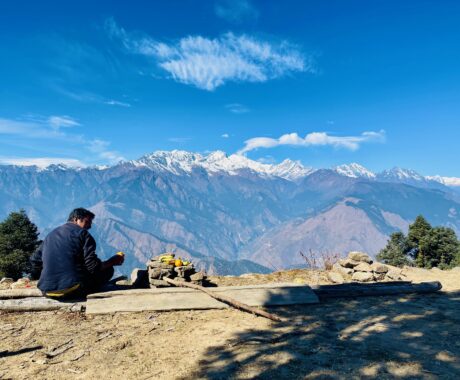
Yala Peak Climb & Langtang Valley Trek
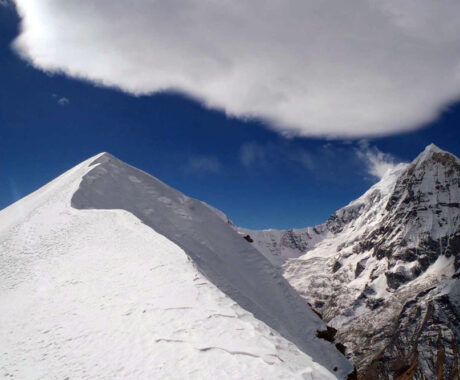
Tent Peak Tharpu Chuli Trek & Climb
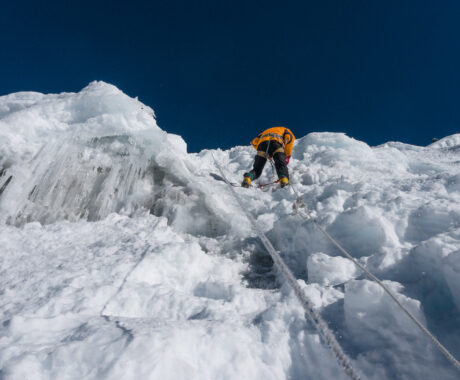
Island Peak & Everest Base Camp Trek

